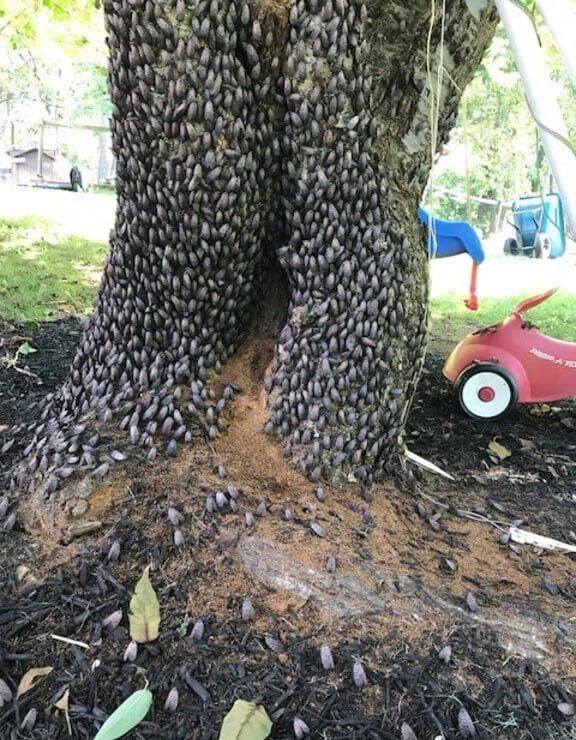The noose of the invasive spotted lanternfly draws ever tighter around the neck of Philadelphia. The plant-hopper can destroy local trees and vines, upsetting the ecosystem and damaging agricultural businesses in the process, and it’s recently been sighted in Philly and the surrounding suburbs.
Eyewitnesses have shared photos of the beautiful but dangerous spotted lanternfly (Lycorma delicatula) in Center City around City Hall. Earlier this week, the Delaware County Council issued a stern warning about the possible risks of an infestation by the bug, which is typically one inch long by half an inch wide. The spotted lanternfly is not a threat to humans, but it can inflict severe damage on local trees.
“We want to make residents aware of the threat and inform them about the best ways to control the population,” Delaware County Council Chairman John McBlain said in a statement. “While they don’t pose a health risk, they do present a threat to Delaware County’s and the state’s agricultural businesses.”
According to the Delaware County Council, this species of bug attacks fruit trees, feeds on sap, and excretes a sticky substance that builds up on and around infested plants, creating a breeding ground for fungi and sooty mold, which can infect and kill plants.
RELATED: How Philly Is Preserving And Regenerating Its Native Forest
The species also reproduces at a breathtaking rate – with each female carrying 100 eggs, the population levels of this bug, once settled into an area, can grow exponentially.
The lanternfly has the potential to threaten Pennsylvania’s $18 billion grape, tree-fruit, hardwood, nursery and landscape industries, Delaware County Council said, in addition to threatening residents’ gardens and general quality of life.
Due to the threat to the state’s economy, the U.S. Department of Agriculture (USDA) gave Pennsylvania $17.5 million in funding to fight the pest earlier this year. Thirteen counties in southeast Pennsylvania are “quarantined.” (Berks, Bucks, Chester, Dauphin, Delaware, Lancaster, Lebanon, Lehigh, Monroe, Montgomery, Northampton, Philadelphia, and Schuylkill).
But none of that has stopped their gradual but inexorable migration southward.

What to do if you see a Spotted Lanternfly
First spotted in Berks County in 2014, the spotted lanternfly has now been spotted throughout southeastern Pennsylvania, as well as in New York, Delaware and Virginia. In addition to killing crops, the spotted lanternfly can cause structural damage to trees, killing them faster when powerful storms come through. One of their favorite homes is the ailanthus tree, or “tree of heaven.”
These reasons are why state officials are urging members of the public to kill the spotted lanternfly on sight – for example, with a shoe, if no other blunt object is at hand.
“The Pennsylvania Department of Agriculture advises that the Adult Spotted Lanternfly and nymphs can be mechanically destroyed, such as being swatted with a shoe,” the Delaware County Council said.
Additionally, anyone traveling between quarantine zones should check themselves, their car and their furniture to see if a spotted lanternfly, known to be a “hitchiker” that camouflages itself into blankets or the exteriors of cars, is using them to hitch a ride.
Parks & Recreation officials confirmed to the Inquirer that the bugs have been spotted in the Wissahickon, on Valley Green Drive, and in West Fairmount Park.
Many experts advise using pesticide to control the spotted lanternfly population. Holistic alternatives could include removing the tree they have chosen to inhabit.
The spotted lanternfly originates in China, India and Vietnam. It’s unknown exactly how it got to the mainland U.S., although the species may have hitched a ride aboard goods being shipped from that region. But as with other invasive, non-native species, the natural predators who keep its population under control at home don’t exist in the Philly area, scientists say.
Residents who see the spotted lanternfly are urged to report the sighting to state authorities by calling 1-888-4BAD-FLY (1-888-422-3359) or by emailing a picture with the bug’s location to [email protected]. For more information about the spotted lanternfly, visit the PA Department of Agriculture online at agriculture.pa.gov.




























